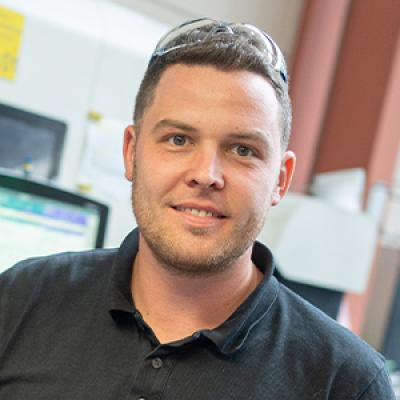Interview with Markus Lindner

We visit Markus Lindner in the metal production at HQ Amstetten. He is a production worker and takes responsibility in his team as an offline programmer who works directly at the CNC lathe-milling machines. It is noisy. It smells of oil and iron. Past cutting machines and robots, we go into the shop floor cabin. A desk with two large monitors. This is where the trained cutting technician programs the machines.

Markus Lindner
"Digitisation helps extremely. We have many more possibilities to really exploit the machine and push it to its limits.“
"Half of my job currently takes place here at the computer. In addition, I am a deputy shift speaker and work directly outside at the machine. So I don't forget anything.“
Markus Lindner is a trained machining technician and works as an offline programmer on the computer and as a production worker directly at the CNC lathe-milling machine.
What is your training like as an offline programmer?
MARKUS LINDNER:
In the beginning, there was extensive training to become a software producer. Since then, it's mainly been learning by doing.
What do you like about your job?
MARKUS LINDNER:
The machining is super. You see how the part takes concrete shape. Only simulating or working on the PC would be nothing for me. I really appreciate the variety. I'm responsible for making sure there's a program for the machine. And I can freely decide how to solve challenges when working, because the result is what counts. The important thing is that the production runs.
How does digitisation help to optimise the products, Mr Lindner?
MARKUS LINDNER: It helps extremely! Specifically, the software is extremely helpful. We have many more opportunities to really exploit the machine and equipment and push it to its limits.
What does it mean when you say pushing the machine to its limits?
MARKUS LINDNER: Directly on site in production, we have a significant influence on the success of a product. In other words, whether it can be manufactured at competitive costs. This is exactly what digitisation helps us to do. Before we produce a part (note: in metalworking), we simulate it and optimise it on the digital twin.
You are working on the digital twin?
MARKUS LINDNER: We have created a digital twin of the CNC lathe-milling machines. That's where I create the programs. So it's no longer done manually on the machine but in its digital twin on the desktop.
Everything is simulated there so that the intervention doesn't take place directly on the machine, as it used to, and there is no downtime. We program how we make the parts and on which machine. My job is to reduce the downtime and keep it as short as possible. The CNC programmes are constantly optimised in terms of cost and quality of the products.
What does your job look like today?
MARKUS LINDNER: I learned machining technology at the Doka training workshop. Half of my job currently takes place here at the computer. In addition, I am a deputy shift spokesperson and work directly outside on the CNC lathes and milling machines. So I don't forget anything.
The changeover phase towards digital twin and offline programming took place in 2019. Before that, I worked on the machines. And there was direct programming. There were downtimes when the machines were not producing. Programmes could not be used to their full potential and products could not be optimised so easily. With digitalisation and software, things are much better now.
What do you manufacture specifically?
MARKUS LINDNER: Accessories and tools for formwork. For example, anchor parts, threaded parts, different milled parts. We manufacture the parts directly from the raw material. I pay attention to different material grades and select the best manufacturing techniques.
What do you do with it?
MARKUS LINDNER: We machine it, which means cutting, turning, milling, drilling. Today this is done on fully automatic machines, a robot or a gantry takes over the handling.



